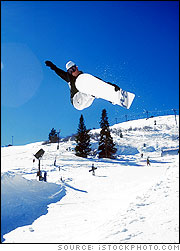2014 Olympics: Snowboarding


U.S.-dominated crowd pleaser
 Related Links |
The United States is a force to be reckoned with when it comes to snowboarding. The athletes are strong, and the team is deep.
At Sochi, snowboarding makes its fifth Olympic appearance. The sport, which first appeared at the 1998 Nagano Games, is still a work in progress as events are changed and added. For the 2014 Games, two new events will debut: slopestyle and parallel slalom. With the additions, there are 10 snowboarding events: men's and women's halfpipe, men's and women's parallel giant slalom, men's and women's snowboard cross, men's and women's slopestyle, and men's and women's parallel slalom.
Slopestyle, set on a downhill course, combines aerial tricks and stunts performed on boxes and rails. Riders are not timed; instead they are scored for the difficulty and style of their tricks. Watch out for the 2012 World Snowboarding Tour slopestyle champion Chas Guldemond and Eric Willett, a darling of the X Games. For the women, Jamie Anderson, who has seven X Games medals to her credit, hopes to land a place on the podium.
In snowboard cross, the course is made up of different sections: whoops (moguls), waves, banks, kickers, and spines (jumps with 90° angles), with a series of blue and red gates and triangular flags marking the course and indicating entrances to obstacles.
The half-pipe is probably the most excitng snowboarding event to watch. Athletes perform acrobatic, aerial twists and turns high above the rim of the half-pipe. Snowboarding legend Shaun White, a.k.a The Flying Tomato, won the gold medal in the half-pipe at both the 2006 and 2010 Winter Games. In Vancouver, he landed his trademark double McTwist 1260. He's expected to turn in another high-flying performance in Sochi. White also happens to be a world-class skateboarder. On the women's side, expectations are high for Kelly Clark, who won gold at the Salt Lake City games in 2002 and a bronze in Vancouver. And watch out for half-pipe phenoms Elena Hight and Gretchen Bleiler.
In the half-pipe, each run is scored on a scale of 0.1 to 10.0 by a panel of five judges. One judge scores the standardized moves, another scores amplitude (the height of maneuvers), one scores quality of rotations, and two score overall impression. For the amplitude score, each maneuver is given an additional point for every 30 centimeters that the competitor reaches above the lip of the pipe. The scores for each maneuver are averaged to determine the final amplitude score. Falls and other mistakes lead to deductions.
In the parallel giant slalom, the racers take qualifying runs down a course, making turns around gates. The top 16 men and top 16 women are ranked according to their times. Then they face off in a bracket format with 1 against 16, 2 against 15, etc. The two snowboarders compete in a two-race match (once on each course). The winner is the racer who posts the best total time. The winners of each match move on to the next round until the semifinals. The two semifinals winners race for the gold (the loser gets the silver) and the semifinals losers race for the bronze.
Parallel slalom has two snowboarders racing side by side down parallel courses laid out exactly the same and turning through gates. Justin Reiter is the U.S.'s best hope for a medal in Sochi.
